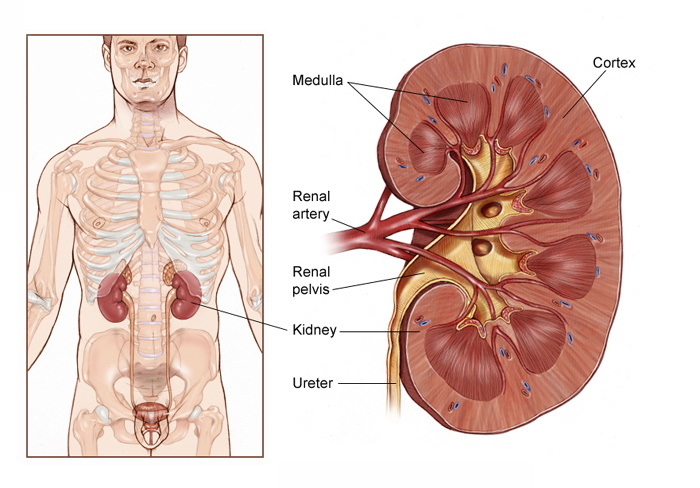
Renal Cancer: Types of Kidney Cancer
Kidney cancer, also called renal cancer, is one of the most common types of cancer in the world.
Renal cancer is one of the top 10 most common cancers in the United States, with more than 76,000 new cases diagnosed each year. More men than women are diagnosed with renal cancer. Kidney cancer can be seen in anyone but is more common in African Americans, American Indians and Alaskan Native people. You can get Renal cancer is more common in older people (those greater than 75 years old). The earlier kidney cancer is diagnosed – the better chances of survival.
Basic Facts About Kidneys
Every person has 2 kidneys, which are located above the waist on both sides of the spine. These reddish-brown, bean-shaped organs are each about the size of a small fist. They are located closer to the back of the body than to the front.
The kidneys filter blood to remove impurities, excess minerals and salts, and extra water. Every day, the kidneys filter about 200 quarts of blood to generate 2 quarts of urine.
The kidneys also produce hormones that help control blood pressure, red blood cell production, and other bodily functions.
Most people have 2 kidneys. Each kidney works independently. This means the body can function with less than 1 complete kidney. With dialysis, a mechanized filtering process, it is possible to live without functioning kidneys.
Dialysis can be done through the blood, called hemodialysis, or by using the patient’s abdominal cavity, called peritoneal dialysis.
Renal Cancer
Renal cancer begins when healthy cells in 1 or both kidneys change and grow out of control, forming a mass called a renal cortical tumor.

A tumor can be malignant, indolent, or benign.
- A malignant tumor is cancerous, meaning it can grow and spread to other parts of the body.
- An indolent tumor is also cancerous, but this type of tumor rarely spreads to other parts of the body.
- A benign tumor means the tumor can grow but will not spread.
Types of Renal Cancer
There are several types of renal cancer:
1. Renal Cell Carcinoma
Renal cell carcinoma is the most common type of adult kidney cancer, making up about 85% of diagnoses. This type of cancer develops in the proximal renal tubules that make up the kidney’s filtration system. There are thousands of these tiny filtration units in each kidney.
2. Urothelial Carcinoma
This is also called transitional cell carcinoma. It accounts for 5% to 10% of the renal cancers diagnosed in adults. Urothelial carcinoma begins in the area of the kidney where urine collects before moving to the bladder, called the renal pelvis.
This type of renal cancer is treated like bladder cancer because both types of cancer begin in the same cells that line the renal pelvis and bladder.
3. Sarcoma
Sarcoma of the kidney is rare. This type of cancer develops in the soft tissue of the kidney; the thin layer of connective tissue surrounding the kidney, called the capsule; or surrounding fat.
Sarcoma of the kidney is usually treated with surgery. However, sarcoma commonly comes back in the kidney area or spreads to other parts of the body. More surgery or chemotherapy may be recommended after the first surgery.
4. Wilms Tumor
Wilms tumor is most common in children and is treated differently from renal cancer in adults. Wilms tumors make up about 1% of renal cancers.
This type of tumor is more likely to be successfully treated with radiation therapy and chemotherapy than the other types of renal cancer when combined with surgery. This has resulted in a different approach to treatment.
5. Lymphoma
Lymphoma can enlarge both kidneys and is associated with enlarged lymph nodes, called lymphadenopathy, in other parts of the body, including the neck, chest, and abdominal cavity.
In rare cases, renal lymphoma can appear as a lone tumor mass in the kidney and may include enlarged regional lymph nodes. If lymphoma is a possibility, your doctor may perform a biopsy and recommend chemotherapy instead of surgery.
Types of Renal Cancer Cells
Knowing which type of cell makes up a renal tumor helps doctors plan treatment. Pathologists have identified more than 30 different types of renal cancer cells.
A pathologist is a doctor who specializes in interpreting laboratory tests and evaluating cells, tissues, and organs to diagnose disease. Computed tomography (CT) scans or magnetic resonance imaging (MRI) cannot always show the difference between benign, indolent, or malignant renal cortical tumors before surgery.

The most common types of renal cancer cells are listed below. In general, the grade of a tumor refers to the degree of differentiation of the cells, not how fast they grow.
Differentiation describes how much the cancer cells look like healthy cells. The higher the grade, the more likely the cells are to spread or metastasize over time.
1. Clear Cell
About 70% of kidney cancers are made up of clear cells. Clear cells range from slow growing (grade 1) to fast growing (grade 4). Immunotherapy and targeted therapy are particularly effective at treating clear cell kidney cancer.
2. Papillary
Papillary renal cancer is found in 10% to 15% of patients. It is divided into 2 different subtypes, called type 1 and type 2. Localized papillary kidney cancer is often treated with surgery.
If papillary renal cancer spreads or metastasizes, it is often treated with blood vessel blocking agents. Using immunotherapy to treat metastatic papillary cancers is still being researched. Many doctors recommend treatment through a clinical trial for metastatic papillary cancers.
3. Sarcomatoid Features
Each of the tumor subtypes of kidney cancer (clear cell, chromophobe, and papillary, among others) can show highly disorganized features under the microscope. These are often described by pathologists as “sarcomatoid.”
This is not a distinct tumor subtype, but when these features are seen, doctors are aware that this is a very aggressive form of kidney cancer. There is promising scientific research for immunotherapy treatment options for people with a tumor with sarcomatoid features.
Most recently, these included combinations of ipilimumab (Yervoy) and nivolumab (Opdivo) as well as combinations of atezolizumab (Tecentriq) and bevacizumab (Avastin).
4. Medullary
This is a rare and highly aggressive cancer but is still considered a renal cortical tumor. It is more common in Black people and is highly associated with having sickle cell disease or sickle cell trait. Sickle cell trait means that a person has inherited the sickle cell gene from a parent.
Combinations of chemotherapy with blood vessel inhibitors are currently recommended treatment options based on some scientific data, and clinical trials are ongoing to better define treatment decisions.
5. Collecting Duct
Collecting duct carcinoma is more likely to occur in people between the ages of 20 and 30. It begins in the collecting ducts of the kidney.
Therefore, collecting duct carcinoma is closely related to transitional cell carcinoma. This is a difficult cancer to treat successfully long-term, even with combinations of systemic chemotherapy and surgery.
6. Chromophobe
Chromophobe is another uncommon cancer that may form indolent tumors that are unlikely to spread but are aggressive if they do. Clinical trials are ongoing to find the best ways to treat this type of cancer.
7. Oncocytoma
This is a slow-growing type of renal cancer that rarely, if ever, spreads. The treatment of choice is surgery for large, bulky tumors.
8. Angiomyolipoma
Angiomyolipoma is a benign tumor that has a unique appearance on a CT scan and when viewed under a microscope. Usually, it is less likely to grow and spread. It is usually treated with surgery or, if it is small, with active surveillance.
Significant bleeding is a rare event but more likely in pregnant and premenopausal women. An aggressive form of angiomyolipoma, called epithelioid, can in rare instances invade the renal vein and inferior vena cava and spread to nearby lymph nodes or organs, such as the liver.



